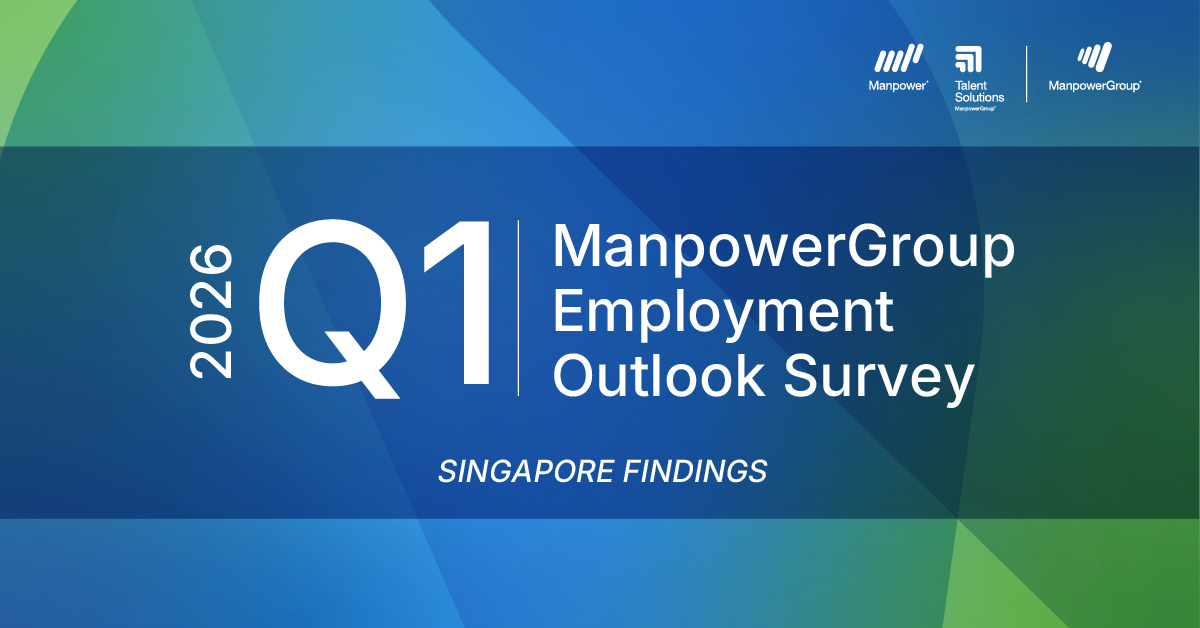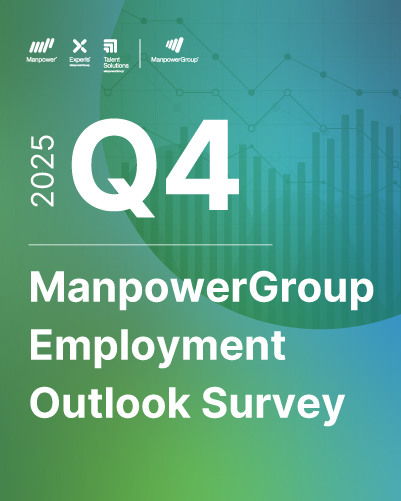ManpowerGroup Employment Outlook Survey
Get insights on Singapore's employers' hiring plans across nine sectors.
Read the ReportA message from Ms. Linda Teo, ManpowerGroup Singapore Country Manager
“Singapore’s hiring outlook reflects a period of recalibration as employers adjust workforce strategies. More employers are focused on maintaining staffing levels or holding off on making staffing decisions while waiting to see how economic conditions evolve, while those hiring are doing so strategically, driven by organizational growth, diversity initiatives and maintaining a competitive advantage. Looking ahead, hiring sentiment is expected to remain measured as external pressures and softer global demand influence business confidence.”
Key Findings
- Singapore hiring outlook eases to lowest level in nearly four years: Singapore’s Net Employment Outlook (NEO) for Q1 2026 stands at +15%, weakening by five points from Q4 2025 and 11 points year-over-year. This marks the lowest NEO since Q1 2022, when it last stood at +15%.
- The largest share of employers expect to maintain headcount: Nearly half (46%) expect to maintain current staffing levels, while 32% plan to increase headcount and 18% anticipate a decrease in their staffing levels.
- The strongest Outlooks by sector: Across the sectors, the Finance & Insurance industry reports the strongest Outlook of +33%—increasing 23 points from the previous quarter but decreasing 6 points year-over-year.
Downloads
ManpowerGroup interviewed 504 employers in Singapore on their hiring intentions for Q1 2026. Download our press release and report to learn more about the survey results and take a deeper dive into global trends and key findings.
Find The Talent and Solutions You Need
To discuss the results personally or explore how ManpowerGroup can help you find the talent and solutions needed to propel your organization forward, contact us today.
Past ManpowerGroup Employment Outlook Reports
About the ManpowerGroup Employment Outlook Survey
What is the ManpowerGroup Employment Outlook Survey?
The ManpowerGroup Employment Outlook Survey measures employers’ intentions to increase or decrease the number of employees in their workforce during the upcoming quarter. It is the most extensive forward-looking survey of its kind, unparalleled in its size, scope and longevity. The Survey has been running since 1962 and is one of the most trusted indicators of labor market trends in the world.
What questions do you ask in the survey?
All the data in the survey is based on the answer to one question: How do you anticipate total employment at your location to change in the coming three months as compared to the current quarter?
In addition to the main employment question, the survey asks up to six additional questions which change quarterly. These questions reflect changing economic or workforce dynamics and trends. Topic areas range from talent shortage to workforce training and development to employee sentiments and well-being.
What is meant by Net Employment Outlook (NEO)?
The Net Employment Outlook is derived by taking the percentage of employers anticipating an increase in hiring activity and subtracting from this the percentage of employers that expect to see a decrease in employment at their location in the next quarter. A positive Net Employment Outlook figure means that, on balance, there are more employers who expect to add to their headcount in the following three months than those who intend to reduce staff.
Does the survey provide data on planned employment changes?
The ManpowerGroup Employment Outlook Survey only measures if employers expect to hire or not and does not provide information about specific job changes. The Survey is a forecast, not a commitment, based on informed opinions from employers and hiring managers on what will likely happen in their organization in the following quarter.
How large is the sample worldwide?
The Q1 2026 ManpowerGroup Employment Outlook Survey is based on interviews with 39,063 public and private employers in 41 countries and territories.
What is the survey methodology?
The methodology used to collect the data for the Employment Outlook is digitized across the 41 markets, beginning with the Q1 2022 report.
Respondents in previous quarters were contacted via telephone. Data is now collected online with double opt-in member panels and they are incentivized to complete the survey.
The survey participants are not derived from ManpowerGroup’s customer base. To protect the integrity of the data, survey respondents remain completely anonymous and confidential.
In line with standard findings of online surveys, more people are now taking a position – selecting that their workforce will either increase or decrease vs. no change. Because the Net Employment Outlook is based only on the people saying increase or decrease, the result of this higher level of engagement means the methodology shift may contribute to a higher Outlook.
For the Q4 2025 report, the survey responses were collected between 1 Jul - 31 Jul.
What is the updated industry sector classification in the latest MEOS report?
ManpowerGroup has introduced an updated industry sector classification to ensure our insights more closely reflect today’s global economy. Beginning with Q1 2026, data will be reported across nine sectors: Construction & Real Estate; Finance & Insurance; Hospitality; Information; Manufacturing; Professional, Scientific & Technical Services; Public Sector, Health & Social Services; and Trade & Logistics. Historical data has been reclassified to maintain consistency over time, and national and regional results remain unchanged. This update enhances comparability with other research and ensures greater relevance for clients, media, and market stakeholders
Tech & IT Services is a specialty sector that combines subsectors across Manufacturing, Information, and Professional Services to provide a holistic view of all aspects relating to IT and telecoms.
How are companies selected for the survey?
Employers are selected based on the types of companies and organizations they represent. We want to ensure that our panel is representative of each participating country’s national labor market, so each country’s panel is built in proportion to that country’s overall distribution of industry sectors and organization sizes.
Who do you interview in each company?
The person we select to interview will be someone with a good overview of staffing levels and hiring intentions within their organization. Normally this will be the head of HR or an HR manager. However, in smaller organizations, that person may be a general manager or even the CEO.
Who conducts the research?
Reputation Leaders is our lead research partner who analyzes data for all 41 countries and territories to ensure consistency.
Can you explain the Margin of Error calculation?
By their very nature, surveys are imperfect measures. All surveys have a margin of error, which is largely determined by the number of interviews completed. For the ManpowerGroup Employment Outlook Survey, the minimum panel size in each country and territory is 620 to ensure a margin of error no greater than +/-3.9%. This prevents undue distortion of the data because of one respondent changing their response from one quarter to the next. No single panel member represents more than 2% of the total sample in an industry sector or region.
Why do you seasonally adjust the data?
Seasonal adjustment is a statistical process that allows the Survey data to be presented without the impact of hiring fluctuations that normally occur through the course of the year, usually as a result of various external factors, such changes in weather, traditional production cycles and public holidays. Seasonal adjustment has the effect of flattening peaks and smoothing troughs in the data to better illustrate underlying employment trends and provide a more accurate representation of the ManpowerGroup Employment Outlook Survey results.
How do you know if hiring intentions reported come to fruition?
ManpowerGroup does not track retrospective hiring trends as part of the Employment Outlook Survey, only forward-looking expectations. However, we are able to see that the Survey results do align with employment trends reported by governments and other organizations quite closely and provide one of the most robust and trusted indicators of forward-looking labor market trends in the world.
What is the best way to analyze the results?
There are several ways to review the results which are reported for 41 countries across 4 regions and specific industries within each. The current results, including the Net Employment Outlook, provide a snapshot of employers’ expectations for the coming three months.
Comparing this result to the previous quarter provides a short-term perspective of hiring expectations in a particular country or sector, while comparing to the previous year gives a longer-term view on employer intentions.


.jpg)




